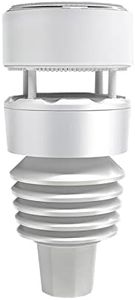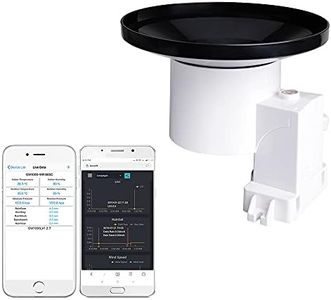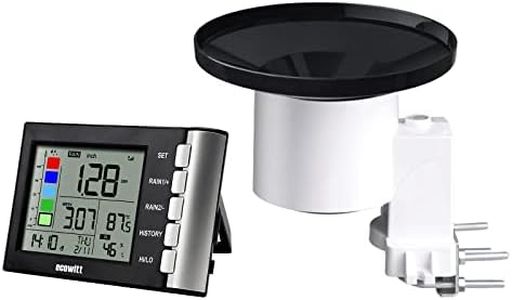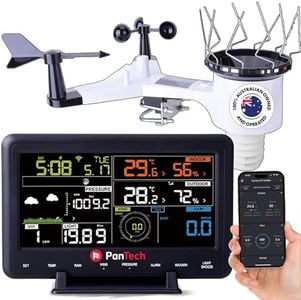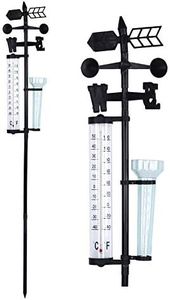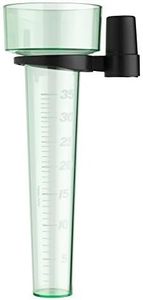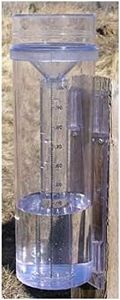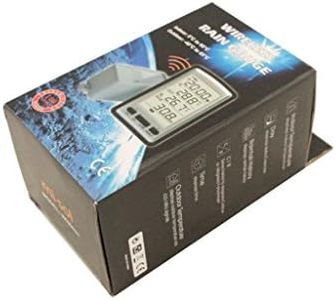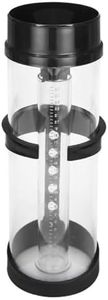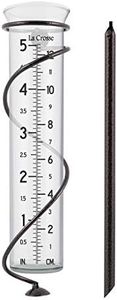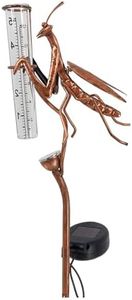We Use CookiesWe use cookies to enhance the security, performance,
functionality and for analytical and promotional activities. By continuing to browse this site you
are agreeing to our privacy policy
10 Best Rain Gauges
From leading brands and best sellers available on the web.Buying Guide for the Best Rain Gauges
When choosing a rain gauge, it's important to think about where you'll use it, how precise you want your measurements to be, and how much effort you want to put into reading and maintaining it. A rain gauge helps you measure the amount of rainfall over a period of time, which is useful for gardening, farming, research, or simply for curiosity about local weather patterns. There are different types of rain gauges, and knowing what features matter will help you pick one that matches your needs.Type (Manual vs. Digital)The type of rain gauge refers to how the rainfall measurements are collected and read. Manual rain gauges collect rain in a tube or container and you check how much has accumulated by looking at the markings. Digital (automatic) rain gauges use sensors and often display results electronically, sometimes even sending data to your phone or computer. Manual types are simple and reliable, but require you to check them regularly. Digital ones are convenient for continuous tracking and remote monitoring but need batteries or power and might require a bit more setup. Choose manual if you enjoy simple, hands-on checks and don’t mind occasional visits, or digital if you prefer convenience or want to track patterns without much effort.
Measuring CapacityMeasuring capacity is how much rain the gauge can hold before it overflows or needs emptying. Rainfall can be light or very heavy depending on your region. Some gauges hold just a few inches or centimeters, while others can capture much more. If you live in an area with frequent or heavy rain, a larger capacity gauge is helpful, so it won’t overflow and give inaccurate readings. For lighter rainfall areas or if you plan to empty it often, a smaller gauge works just fine. Think about the typical rainfall in your area and pick a gauge that won't overflow before you get a chance to check it.
Measurement PrecisionMeasurement precision is about how finely you can read the amount of rain. Some rain gauges are marked with small increments so you can measure rainfall very closely, while others have larger increments and give a rougher estimate. High-precision gauges are useful for scientific or garden research or if you want very accurate data. For more casual use, coarse increments are enough. If accuracy is important to you—for instance, tracking for gardening or weather records—look for gauges with fine, easy-to-read markings.
Material and DurabilityRain gauges are made from various materials like plastic, glass, or metal. The material affects how sturdy the gauge is and how long it will last outdoors. Plastic is lightweight and safe if dropped but can discolor in the sun over time. Glass offers better visibility and accuracy but is breakable, while metal is sturdy but may rust unless coated. If you want something low-maintenance that will last outdoors year-round, look for UV-resistant plastic or rustproof metal. If you’re careful and want better visibility, glass might suit you, but handle with care.
Ease of Installation and PlacementThis refers to how simple it is to set up the rain gauge and where you can place it. Some gauges just spike into the ground, while others mount on posts or fences. Lightweight models are easy to move, while heavier or mounted ones stay put even in windy weather. Consider where you want to put your rain gauge—an open area away from trees and roofs is best for accuracy. If you value flexibility, pick a model that's simple to reposition. If you want a permanent spot and less risk of tipping, select one designed for sturdy mounting.
